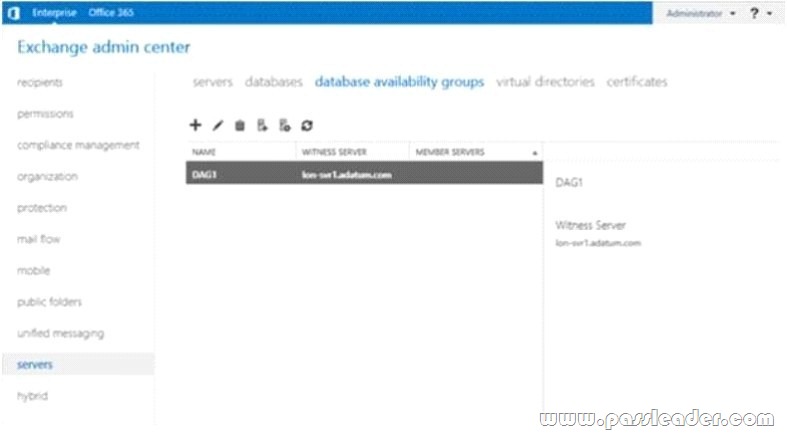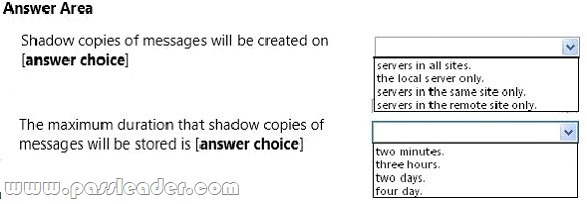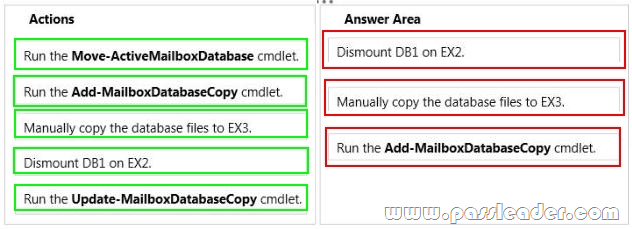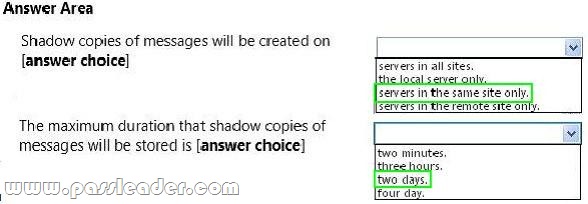Valid 70-341 Dumps shared by PassLeader for Helping Passing 70-341 Exam! PassLeader now offer the newest 70-341 VCE dumps and 70-341 PDF dumps, the PassLeader 70-341 exam questions have been updated and ANSWERS have been corrected, get the newest PassLeader 70-341 dumps with VCE and PDF here: http://www.passleader.com/70-341.html (261 Q&As Dumps –> 272 Q&As Dumps)
BTW, DOWNLOAD part of PassLeader 70-341 dumps from Cloud Storage: https://drive.google.com/open?id=0B-ob6L_QjGLpfjZ2U1ZfVEZvU0ZreTJkNG1xdmxjS0xUYkdHWVMxWFNRVDhOYTlyRzBjOXM
QUESTION 161
You have an Exchange Server 2013 organization. You plan to assign the default workload management policy to all of the servers in the organization. You need to remove the Calendar Synchronization Assistant workload from the workload management policy before you assign the policy to the servers. Which cmdlet should you run?
A. Remove-ResourcePolicy
B. Set-ResourcePolicy
C. Set-WorkloadPolicy
D. Remove-WorkloadPolicy
Answer: D
Explanation:
New-WorkloadManagementPolicy.
EXAMPLE 1
This example creates a custom workload management policy that will be used to control Exchange workloads at the Dublin, Ireland location of Contoso.com. The name of the server in the Dublin, Ireland location of Contoso.com is Dublin01.
New-WorkloadManagementPolicy -Name DublinWorkloadManagementPolicy -DomainController Dublin02.contoso.com
Set-ExchangeServer -WorkloadManagementPolicy DublinWorkloadManagementPolicy -Identity Dublin01
EXAMPLE 2
This example uses the Template parameter to create a policy object DallasWorkloadManagementPolicy based on the Default Workload Management Policy. It is then customized to remove the ELC Assistant workload from the Workload Management Policy. The Workload Management Policy is then assigned to server Dallas01.
New-WorkloadManagementPolicy -Name DallasWorkloadManagementPolicy -Template DefaultWorkloadManagementPolicy_15.0.505.0 Remove-WorkloadPolicy DallasWorkloadManagementPolicy\ELCAssistant Set-ExchangeServer -WorkloadManagementPolicy DallasWorkloadManagementPolicy -Server Dallas01
http://technet.microsoft.com/en-us/library/jj150485(v=exchg.150).aspx
http://technet.microsoft.com/en-us/library/jj215703(v=exchg.150).aspx
QUESTION 162
You have an Exchange Server 2013 organization named fabrikam.com. You have a distribution group named DL1 and a user named User1. The managedBy attribute of DL1 is fabrikam.com\users\User1. User1 attempts to add a user named User2 to DL1 and receives the following error message:
“Changes to the public group membership cannot be saved.
You do not have sufficient permissions to perform this operation on this object.”
You need to ensure that User1 can add User2 to DLL. What are two possible ways to achieve this goal? (Each correct answer presents a complete solution. Choose two.)
A. From Exchange Management Shell, run New-ManagementRoleAssignment -Name
“Default Role Assignment Policy-MyDistributionGroupMembership” -Policy
“Default Role Assignment Policy” -Role “MyDistributionGroupMembership
B. From Exchange Admin Center, edit the Default Role Assignment Policy and select MyDistributionGroups
C. From Exchange Management Shell, run New-ManagementRoleAssignment -Name
“Default Role Assignment Policy-MyDistributionGroups” -Policy
“Default Role Assignment Policy” -Role “MyDistributionGroups”
D. From Exchange Admin Center, edit the Default Role Assignment Policy and select MyDistributionGroupMembership
Answer: AC
Explanation:
http://technet.microsoft.com/en-gb/library/jj657511(v=exchg.150).aspx
Role Assignment Policies cannot be managed via the EAC.
QUESTION 163
Your company has four offices. Each office connects to two of the other offices by using a direct WAN link. Each office is configured as an Active Directory site. The office connections and the Active Directory site links are configured as shown in the exhibit. (Click the Exhibit button.)

You have Exchange Server 2013 organization that contains four servers. The servers are configured as shown in the following table.

You discover that email messages sent from the site in Montreal to the site in Miami are routed through the site in New York. You need to ensure that all of the email messages sent from the Montreal site to the Miami site are routed through the Washington site. What should you run?
A. Set-AdSite1ink Site1inkl -ExchangeCost 25
B. Set-AdSite Washington’ -HubSiteEnabled $false
C. Set-AdSite1ink SiteUnkl -ExchangeCost 15
D. Set-AdSite New York’ -Hubsiteenabled Sfalse
Answer: C
Explanation:
Set-AdSiteLink.
This cmdlet is available only in on-premises Exchange Server 2013. Use the Set-AdSiteLink cmdlet to assign an Exchange-specific cost to an Active Directory IP site link. You can also use this cmdlet to configure the maximum message size that can pass across an Active Directory IP site link.
EXAMPLE 1
This example assigns an Exchange-specific cost of 25 to the IP site link DEFAULT_IP_SITE_LINK and configures a maximum message size limit of 10 MB on the IP site link.
Set-AdSiteLink DEFAULT_IP_SITE_LINK -ExchangeCost 25 -MaxMessageSize 10MB
By default, Microsoft Exchange determines the least cost routing path by using the cost assigned to the Active Directory IP site link. You can use the Set-AdSiteLink cmdlet to assign an Exchange-specific cost to the Active Directory IP site link. The Exchange-specific cost is a separate attribute used instead of the Active Directory-assigned cost to determine the least cost routing path. This example sets an Exchange specific cost of 10 to the IP site link IPSiteLinkAB.
Set-AdSiteLink -Identity IPSiteLinkAB -ExchangeCost 10
http://technet.microsoft.com/en-us/library/bb123696(v=exchg.150).aspx
http://technet.microsoft.com/en-gb/library/bb266946(v=exchg.141).aspx
QUESTION 164
Hotspot Question
Your network contains an Active Directory forest. The forest contains two sites named Site1 and Site2. You have an Exchange Server 2013 organization. Site1 contains two Mailbox servers and one Client Access server. Site2 contains two Mailbox servers and two Client Access servers. You need to prevent messages that cannot be protected by shadow redundancy from being delivered. What command should you run? (To answer, select the appropriate options in the answer area.)

QUESTION 165
Hotspot Question
You have an Exchange Server 2013 organization that contains two Mailbox servers named EX01 and EX02. Both servers are in the same Active Directory site. On EX01, you create the first public folder mailbox in a database named DB1. You view the Exchange Admin Center as shown in the exhibit. (Click the Exhibit button.)

Use the drop-down menus to select the answer choice that completes each statement.

QUESTION 166
Drag and Drop Question
You have an Exchange Server 2013 organization that contains two servers named EX1 and EX2. EX1 and EX2 are the members of a database availability group (DAG) named DAG1. DAG1 contains a database named DB1. DB1 is active on EX1. You deploy a new Exchange Server 2013 server named Ex3. You add EX3 as a member of DAG1. You need to add a copy of DB1 to EX3 by using an offline copy of the database. Which three actions should you perform in sequence? (To answer, move the appropriate three actions from the list of actions to the answer area and arrange them in the correct order.)

QUESTION 167
Hotspot Question
You have an Exchange Server 2013 organization. You have a user named User1 and a user named User2. Both users access their email by using Microsoft Outlook 2013. You need to ensure that User2 can access all of the email messages in the mailbox of User1 the next time User2 opens Outlook. What command should you run? (To answer, select the appropriate options in the answer area.)

QUESTION 168
Drag and Drop Question
You have an Exchange Server 2013 organization that contains five servers. Several employees plan to use Microsoft Outlook to collaborate on some projects. You need to configure access to Outlook to meet the following requirements:
– Several employees must be able to send email messages as a user named User1.
– Several employees must be able to send email messages on behalf of a user named User2.
Which cmdlets should you use? To answer, drag the appropriate crndlet to the correct requirement in the answer area. Each crndlet may be used once, more than once, or not at all. Additionally, you may need to drag the split bar between panes or scroll to view content.

QUESTION 169
You have an Exchange Server 2013 organization. You need to ensure that users receive a notification if the delivery of a message is delayed for more than one hour. Which cmdlet should you use?
A. Set-FrontEndTransportService
B. Set-MailboxTransportService
C. Set-Tra nsportConfig
D. Set-TransportService
Answer: D
Explanation:
http://technet.microsoft.com/en-us/library/jj215682(v=exchg.150).aspx
EXAMPLE 1
This example sets the DelayNotificationTimeout parameter to 1 hour for the Transport service on a Mailbox server named Mailbox01.
Set-TransportService Mailbox01 -DelayNotificationTimeout 1:00:00
DelayNotificationTimeout.
The DelayNotificationTimeout parameter specifies how long the server waits before it generates a delayed delivery status notification (DSN) message. The default value is 4 hours. To specify a value, enter it as a time span: dd.hh:mm:ss where d = days, h = hours, m = minutes, and s = seconds. For example, to specify 3.5 hours for this parameter, use 03:30:00. The valid input range for this parameter is from 00:00:01 through 30.00:00:00. The value of the DelayNotificationTimeout parameter should always be greater than the value of the TransientFailureRetryCount parameter multiplied by the value of the TransientFailureRetryInterval parameter.
QUESTION 170
Hotspot Question
Your network contains an Active Directory forest named contoso.com. The forest contains two domains named contoso.com and nwtraders.com. You plan to deploy a new Exchange Server 2013 organization named Contoso. You need to ensure that you can deploy the first Exchange Server 2013 server to the forest root domain. What command should you run before you deploy the first Exchange Server 2013 server? (To answer, select the appropriate options in the answer area.)

QUESTION 171
You have an Exchange Server 2010 organization. You deploy a server that has Exchange Server 2013 installed. You plan to install five additional servers that have Exchange Server 2013 installed. You are a member of the Organization Management management role group. Your company hires an external IT consultant named Admin1. The company’s security policy states that all external consultants must have the minimum number of required permissions on the network. You need to ensure that Admin1 can install a server named EX2. The solution must meet the requirements of the security policy. Which two tasks should you perform? (Each correct answer presents part of the solution. Choose two.)
A. Add Admin1 to the Exchange Server role group.
B. Create a new management role and a new role assignment policy.
C. Run setup and specify the/newprovisionectservenex2 parameter.
D. Add Admin1 to the Delegated Setup management role group.
Answer: CD
Explanation:
http://technet.microsoft.com/en-gb/library/dd876881(v=exchg.150).aspx
Delegated Setup.
The Delegated Setup management role group is one of several built-in role groups that make up the Role Based Access Control (RBAC) permissions model in Microsoft Exchange Server 2013. Role groups are assigned one or more management roles that contain the permissions required to perform a given set of tasks. The members of a role group are granted access to the management roles assigned to the role group. Administrators who are members of the Delegated Setup role group can deploy servers running Exchange 2013 that have been previously provisioned by a member of the Organization Management role group. Members of the Delegated Setup role group can only deploy Exchange 2013 servers. They can’t manage the server after it’s been deployed. To manage a server after it’s been deployed, a user must be a member of the Server Management role group.
QUESTION 172
Hotspot Question
Your company has an Exchange Server 2013 organization named contoso.com. All users run Microsoft Outlook 2010 or Outlook 2013. The company recently acquired another company named A. Datum Corporation. All of the users at A. Datum run Linux-based computers and use a third-party IMAP client to access their email messages. You configure IMAP over SSL to use the external URL of mail.contoso.com. You need to publish the IMAP settings to Outlook Web App. What command should you run? (To answer, select the appropriate options in the answer area.)

QUESTION 173
You have an Exchange Server 2013 organization. The help desk reports that users fail to access their mailbox by using the URL http://mail.contoso.com. All of the users successfully connect to their mailbox by using Exchange ActiveSync. You need to ensure that all of the users can access their mailbox by using the URL http://maif.contoso.com. What should you configure on a Client Access server?
A. From Internet Information Services (IIS) Manager, configure HTTP Response Headers on the OWA virtual directory.
B. From Exchange Admin Center, create a new Outlook Web App mailbox policy.
C. From File Explorer, modify the permissions of the Web.config file in the Default Web Site folder.
D. From Internet Information Services (IIS) Manager, configure HTTP Redirect on the default web site.
Answer: D
Explanation:
http://technet.microsoft.com/en-us/library/aa998359(v=exchg.150).aspx
Use IIS Manager to simplify the Outlook Web App URL and force redirection to SSL:
1. Start IIS Manager.
2. Expand the local computer, expand Sites, and then click Default Web Site.
3. At the bottom of the Default Web Site Home pane, click Features View if this option isn’t already selected.
4. In the IIS section, double-click HTTP Redirect.
5. Select the Redirect requests to this destination check box.
6. Type the absolute path of the /owa virtual directory. For example, type https://mail.contoso.com/owa.
7. Under Redirect Behavior, select the Only redirect requests to content in this directory (not subdirectories) check box.
8. In the Status code list, click Found (302).
9. In the Actions pane, click Apply.
10. Click Default Web Site.
11. In the Default Web Site Home pane, double-click SSL Settings.
12. In SSL Settings, clear Require SSL.
Note:
If you don’t clear Require SSL, users won’t be redirected when they enter an unsecured URL. Instead, they’ll get an access denied error.
QUESTION 174
Hotspot Question
You have an Exchange Server 2013 organization that contains four servers. The servers are configured as shown in the following table.

You run Get-TransportConfig and receive the output shown in the exhibit. (Click the Exhibit button.)

Use the drop-down menus to select the answer choice that completes each statement.

QUESTION 175
You have an Exchange Server 2013 organization. You deploy the anti-spam features of Exchange Server 2013. You need to specify the spam quarantine mailbox. Which cmdlet should you run?
A. Set-Mai IboxJunkEmailConfiguration
B. Set-ContentFilterConfig
C. Set-MalwareFilterPolicy
D. Set-SenderFilterConfig
Answer: B
Explanation:
Configure a Spam Quarantine Mailbox.
Messages determined to be spam by the Content Filter agent can be directed to a spam quarantine mailbox. If the spam confidence level (SCL) quarantine threshold is enabled, all messages that are quarantined are wrapped as non-delivery reports (NDR) and are sent to the SMTP address that you specify as the spam quarantine mailbox. You can review quarantined messages and release them to their intended recipients by using the Send Again feature in Microsoft Outlook. By default, anti-spam features aren’t enabled in the Transport service on a Mailbox server. Typically, you only enable the anti-spam features on a Mailbox server if your Exchange organization doesn’t do any prior anti-spam filtering before accepting incoming messages. For more information, see Enable Anti-Spam Functionality on a Mailbox Server. The person responsible for the spam quarantine mailbox can view potentially private and sensitive messages, and then send mail on behalf of anybody in the Exchange organization.
Step 1: Verify content filtering is enabled.
Run the following command to verify the Content Filter agent is installed and enabled on the Exchange server:
Get-TransportAgent “Content Filter Agent”
Run the following command to verify content filtering is enabled:
Get-ContentFilterConfig | Format-List Enabled
Step 2: Create a dedicated mailbox for spam quarantine.
To create a dedicated spam quarantine mailbox, follow these steps:
– Create a dedicated Exchange database
We recommend that you create a dedicated database for the spam quarantine mailbox. The spam quarantine mailbox should have a large database, because if the storage quota limit is reached, messages will be lost. For more information, see Manage Mailbox Databases in Exchange 2013.
– Create a dedicated mailbox and user account
We recommend that you create a dedicated mailbox and Active Directory user account for the spam quarantine mailbox.
Step 3: Specify the spam quarantine mailbox
Set-ContentFilterConfig -QuarantineMailbox <SmtpAddress>
This example sends all messages that exceed the spam quarantine threshold to [email protected].
Set-ContentFilterConfig -QuarantineMailbox [email protected]
http://technet.microsoft.com/en-us/library/aa996791.aspx
http://technet.microsoft.com/en-us/library/aa997692(v=exchg.141).aspx
http://technet.microsoft.com/en-us/library/bb123746(v=exchg.150).aspx
http://jjstellato.blogspot.co.uk/2013/01/exchange-2013-enable-antispam-and.html
QUESTION 176
Your network contain an Active Directory forest. The forest contains a single domain named contoso.com. The network contains a legacy mail system that uses a SMTP namespace of contoso.com. You plan to deploy Exchange Server 2013. There will be a period of interoperability while the email is migrated from the legacy system to Exchange Server 2013. During the period of interoperability, you need to ensure that all incoming email is received by an Exchange Server 2013 server, and then routed to the legacy mail system if an Exchange Server email recipient cannot be found. You configure the firewall in the perimeter network to route SMTP traffic to the Exchange Server 2013 organization. What should you do next?
A. Modify the existing accepted domain for contoso.com and create a new Send connector.
B. Add a new external relay accepted domain for contoso.com and create a new Send connector.
C. Add a new authoritative domain for contoso.com and create a new email address policy.
D. Add a new internal relay accepted domain for contoso.com and create a new email address policy.
Answer: A
Explanation:
http://technet.microsoft.com/en-gb/library/bb124423(v=exchg.150).aspx
Step 1: Modify accepted domain for contoso.com and make it an internal relay domain.
Step 2: Create a new send connector which routes mail for the contoso.com namespace to the legacy namespace -if a recipient cannot be found in the Exchange org.
QUESTION 177
Hotspot Question
You have an Exchange Server 2013 organization that contains three servers. The servers are configured as shown in the following table.

All inbound email messages from the Internet are routed through EX01. You plan to remove EX01 from the organization. You need to ensure that all of the functionalities of EX01 are transferred to EX02 and EX03. The solution must minimize administrative effort. Which functionality should you transfer to each server? (To answer, select the appropriate server for each functionality in the answer area.)

QUESTION 178
Hotspot Question
You have an Exchange Server 2013 organization that contains a database availability group (DAG) named DAG1. DAG1 contains two servers named EX01 and EX02. On EX01, you have three networks. The networks are configured as shown in the following table.

You need to ensure that DAGNetwork02 is the primary replication network and DAGNetwork03 is configured for iSCSI traffic only. What two commands should you run? (To answer, select the appropriate options in the answer area.)

QUESTION 179
Hotspot Question
You have an Exchange Server 2013 organization that contains an accepted domain named contoso.com. A partner company has an Exchange Server 2013 organization named mvtraders.com. Nwtraders.com contains an SMTP server named mail.nwtraders.com. Both organizatiosn only use certificates from the same trusted third-party certification authority (CA). You need to ensure that all email messages received from the SMTP domain named nwtraders.com are protected by using mutual TLS. What command should you run? (To answer, select the appropriate options in the answer area.)

QUESTION 180
You have an Exchange Server 2013 organization that contains 5,000 mailboxes. A user named User1 tests several Windows Phone devices. You need to ensure that User1 can connect more than 20 Windows Phone devices to his mailbox. Which cmdlet should you run?
A. Set-ThrottlingPolicy
B. Set-MobileMailboxPolicy
C. Set-ActiveSyncMailboxPolicy
D. Set-CasMailbox
Answer: A
Explanation:
Example 1:
Set-ThrottlingPolicy-EasmaxDevices 20
Example 2:
New-Throttlingpolicy “Increased ActiveSync Devices” -EasMaxDevices 20
Set-Mailbox steve-ThrottlingPolicy “Increased ActiveSync Devices”
Example 3:
Set-Throttlingpolicy “Increased ActiveSync Devices” -EasMaxDevices 20
http://technet.microsoft.com/en-gb/library/dd298094(v=exchg.150).aspx
http://www.msexchange.org/kbase/ExchangeServerTips/ExchangeServer2010/Mobility/HowtoincreasethemaximumnumberofActiveSyncDevicesforaUser.html
http://thoughtsofanidlemind.com/2014/01/15/eas-device-partnerships/
http://www.slipstick.com/exchange/cmdlets/allow-more-activesync-devices/
Get the newest PassLeader 70-341 VCE dumps here: http://www.passleader.com/70-341.html (261 Q&As Dumps –> 272 Q&As Dumps)
And, DOWNLOAD the newest PassLeader 70-341 PDF dumps from Cloud Storage for free: https://drive.google.com/open?id=0B-ob6L_QjGLpfjZ2U1ZfVEZvU0ZreTJkNG1xdmxjS0xUYkdHWVMxWFNRVDhOYTlyRzBjOXM










